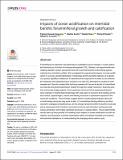Files in this item
Impacts of ocean acidification on intertidal benthic foraminiferal growth and calcification
Item metadata
| dc.contributor.author | Guamán-Guevara, Fabricio | |
| dc.contributor.author | Austin, Heather | |
| dc.contributor.author | Hicks, Natalie | |
| dc.contributor.author | Streeter, Richard | |
| dc.contributor.author | Austin, William E. N. | |
| dc.date.accessioned | 2019-08-22T12:30:02Z | |
| dc.date.available | 2019-08-22T12:30:02Z | |
| dc.date.issued | 2019-08-21 | |
| dc.identifier | 260748055 | |
| dc.identifier | e420a2e3-7d4d-4055-b135-fac5d0d7ad5a | |
| dc.identifier | 85071001310 | |
| dc.identifier | 000485033100008 | |
| dc.identifier.citation | Guamán-Guevara , F , Austin , H , Hicks , N , Streeter , R & Austin , W E N 2019 , ' Impacts of ocean acidification on intertidal benthic foraminiferal growth and calcification ' , PLoS ONE , vol. 14 , no. 8 , e0220046 . https://doi.org/10.1371/journal.pone.0220046 | en |
| dc.identifier.issn | 1932-6203 | |
| dc.identifier.other | RIS: urn:D134A824A2C743FED86EC9F7DFC5B1BD | |
| dc.identifier.other | ORCID: /0000-0003-2261-4540/work/64697925 | |
| dc.identifier.uri | https://hdl.handle.net/10023/18353 | |
| dc.description | Funding: This work is a contribution to FGG’s PhD study programme at the University of St Andrews, UK, and is funded by Secretaría de Educación Superior, Ciencia, Tecnología e Innovación de la República del Ecuador (SENESCYT). | en |
| dc.description.abstract | Foraminifera are expected to be particularly susceptible to future changes in ocean carbonate chemistry as a function of increased atmospheric CO2. Studies in an experimental recirculating seawater system were performed with a dominant benthic foraminiferal species collected from intertidal mudflats. We investigated the experimental impacts of ocean acidification on survival, growth/calcification, morphology and the biometric features of a calcareous species Elphidium williamsoni. Foraminifera were exposed for 6 weeks to four different pH treatments that replicated future scenarios of a high CO2 atmosphere resulting in lower seawater pH. Results revealed that declining seawater pH caused a decline in foraminiferal survival rate and growth/calcification (mainly through test weight reduction). Scanning electron microscopy image analysis of live specimens at the end of the experimental period show changes in foraminiferal morphology with clear signs of corrosion and cracking on the test surface, septal bridges, sutures and feeding structures of specimens exposed to the lowest pH conditions. These findings suggest that the morphological changes observed in shell feeding structures may serve to alter: (1) foraminiferal feeding efficiency and their long-term ecological competitiveness, (2) the energy transferred within the benthic food web with a subsequent shift in benthic community structures and (3) carbon cycling and total CaCO3 production, both highly significant processes in coastal waters. These experimental results open-up the possibility of modelling future impacts of ocean acidification on both calcification and dissolution in benthic foraminifera within mid-latitude intertidal environments, with potential implications for understanding the changing marine carbon cycle. | |
| dc.format.extent | 21 | |
| dc.format.extent | 1216307 | |
| dc.language.iso | eng | |
| dc.relation.ispartof | PLoS ONE | en |
| dc.subject | G Geography (General) | en |
| dc.subject | GC Oceanography | en |
| dc.subject | NDAS | en |
| dc.subject | SDG 14 - Life Below Water | en |
| dc.subject.lcc | G1 | en |
| dc.subject.lcc | GC | en |
| dc.title | Impacts of ocean acidification on intertidal benthic foraminiferal growth and calcification | en |
| dc.type | Journal article | en |
| dc.contributor.institution | University of St Andrews. School of Geography & Sustainable Development | en |
| dc.contributor.institution | University of St Andrews. Bell-Edwards Geographic Data Institute | en |
| dc.contributor.institution | University of St Andrews. Scottish Oceans Institute | en |
| dc.contributor.institution | University of St Andrews. St Andrews Sustainability Institute | en |
| dc.contributor.institution | University of St Andrews. Coastal Resources Management Group | en |
| dc.contributor.institution | University of St Andrews. Marine Alliance for Science & Technology Scotland | en |
| dc.identifier.doi | https://doi.org/10.1371/journal.pone.0220046 | |
| dc.description.status | Peer reviewed | en |
| dc.identifier.url | https://journals.plos.org/plosone/article?id=10.1371/journal.pone.0220046#sec031 | en |
This item appears in the following Collection(s)
Items in the St Andrews Research Repository are protected by copyright, with all rights reserved, unless otherwise indicated.

